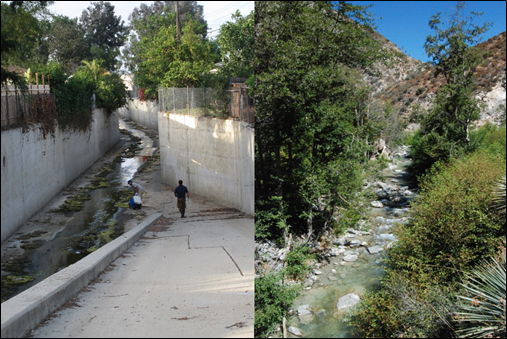Scoring tool developed to quantify habitat condition

SCCWRP and its partners have developed a statewide scoring tool for quantifying the condition of a stream’s physical habitat, enabling watershed managers for the first time to readily interpret and communicate the extensive physical habitat data they collect during routine field assessments of wadeable streams.
The Index of Physical Integrity (IPI), published online in October and described in a technical report, explains how multiple aspects of physical habitat – including streambed substrate, channel morphology and riparian vegetation – influence a stream’s overall ecological health. The IPI produces a single numerical score for a stream site, ensuring physical habitat data are interpreted consistently across California.
Although biological indicators such as benthic algae and macroinvertebrates serve as primary lines of evidence for assessing stream condition, watershed managers have traditionally struggled to determine the causes of low stream bioassessment scores because they had no standardized way to meaningfully analyze and interpret their physical habitat data.
For example, if a stream receives low bioassessment scores, watershed managers need to know if degraded habitat condition could be negatively influencing stream biology. Conversely, if IPI scores are high, managers can focus on determining whether water chemistry (e.g., pollutants) could be responsible for low bioassessment scores.

The IPI providesa key ancillary line of evidence that will support watershed managers in interpreting bioassessment scores generated via the benthic invertebrate-based California Stream Condition Index (CSCI) and its algae-based counterpart, the Algae Stream Condition Index (ASCI), both co-developed by SCCWRP.
The IPI will serve as a key component of the Southern California Stormwater Monitoring Coalition’s (SMC) stream quality index. Expected to be unveiled in mid-2019, this integrative index will use biology, water chemistry and physical habitat data to produce an overall assessment of stream condition.
Additionally, the IPI will be incorporated into ongoing development of a screening-level causal assessment framework intended to rapidly help managers narrow down possible causes of degraded stream condition.
The IPI was built using the same design principles that guided the development of the CSCI. Like the CSCI, the IPI uses statistical modeling to predict what physical habitat should look like for individual stream sites statewide in the absence of pollutants or other stressors; this modeling approach accounts for diverse local environmental conditions found across California.
In developing the IPI, researchers relied extensively on the physical habitat data sets collected by California watershed managers in recent years.
Through the SMC, Southern California watershed managers played a key role in testing an initial version of the IPI. Their feedback led to revisions of the index to optimize its applicability in the South Coast region, particularly in concrete-lined channels.
SCCWRP is now working to support the State Water Board and the SMC with implementation guidance and IPI calculators.
For more information, contact Dr. Raphael Mazor or Dr. Marcus Beck.
More news related to: Bioassessment, Indices of Biotic Integrity, Top News